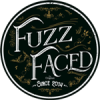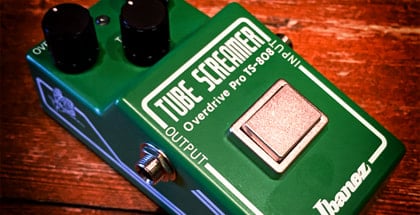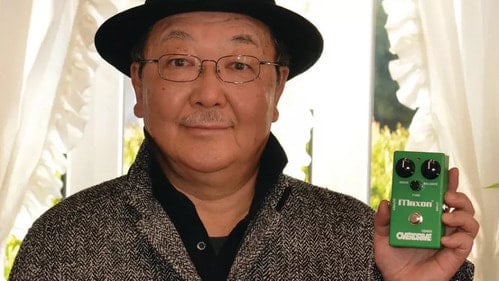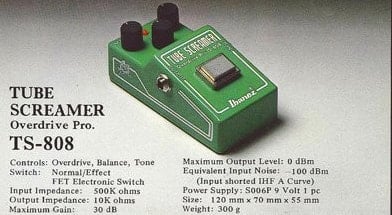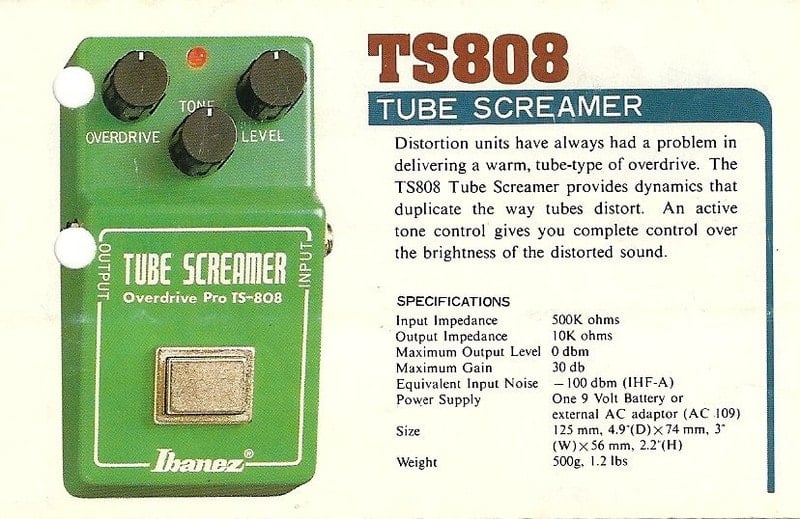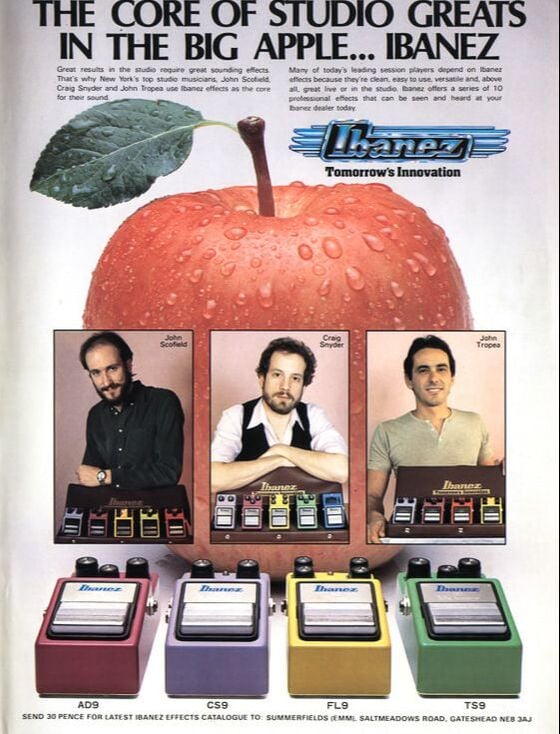Ibanez Tube Screamer: A BRIEF HISTORY
The Ibanez Tube Screamer Overdrive Pro TS808 was released in 1979 and was replaced in 1982 by the TS9 Tube Screamer. Designed by Mr. Susumu Tamura, who could not play the guitar, the TS-808 was manufactured by Maxon and sold by Ibanez, and gathered much of its acclaim for being the overdrive of choice for Stevie Ray Vaughan.
|
It was the one of the first stomp-boxes designed specifically to mimic the sound of a tube amp running at full tilt. “With the OD808, the design goal was not to obtain the overdrive effect alone but to create the sound of the guitar amplifier and overdrive pedal combined,” Mr. Tamura said.
This was quite a revolutionary concept at the time, and it continues to influence the development of guitar effects even today. |
Real tube screamers nerds love to go back and forth about the finer points of every Tube Screamer variation, but the fact is most of them sound pretty much the same. Today Ibanez makes many excellent versions, including reissues, hand wired, mini and bass models.
Ibanez, owned by Hoshino Gakki Ten, started selling guitar effect pedals in 1974, after reaching an agreement with the Nisshin Onpa Factory, owner of the Maxon brand, to market and distribute their products outside of Japan. At that time, Maxon did not have the ability to export products abroad on its own. Therefore, Maxon concentrated on domestic sales only, and overseas export was supplied under the Ibanez brand.
Between 1974 and 1979, two overdrive pedals were already listed in the Ibanez catalog, the OD-850 Overdrive and the OD-855 Overdrive II, but in sound and circuitry these devices more closely resembled fuzz boxes than the smooth, mid-heavy saturation that the Tube Screamer generates.
The term ‘Tube Screamer’ was suggested by Sammy Ash of the Sam Ash Music family, when Mr. Sumusu Tamura first visited Sam Ash Music at West 48th Street, Manhattan. At this time, Sumusu brought a prototype of the Micro Teacher Mini Amp GA-10, a ‘70s-era pedal-size amp. When he connected the GA-10 to the guitar amplifier, it suddenly made a screaming sound, and Sammy asked Mr. Tamura if he knew how the Cry Baby pedal got its name. “Yes,” Mr. Tamura said, “it sounds like a baby crying.” And Sammy said, “This sounds like a screaming tube amp.” So, when the Maxon OD808 Overdrive Pro was born, Ibanez’s overdrive was named the TS808 Tube Screamer Overdrive Pro.
Between 1974 and 1979, two overdrive pedals were already listed in the Ibanez catalog, the OD-850 Overdrive and the OD-855 Overdrive II, but in sound and circuitry these devices more closely resembled fuzz boxes than the smooth, mid-heavy saturation that the Tube Screamer generates.
The term ‘Tube Screamer’ was suggested by Sammy Ash of the Sam Ash Music family, when Mr. Sumusu Tamura first visited Sam Ash Music at West 48th Street, Manhattan. At this time, Sumusu brought a prototype of the Micro Teacher Mini Amp GA-10, a ‘70s-era pedal-size amp. When he connected the GA-10 to the guitar amplifier, it suddenly made a screaming sound, and Sammy asked Mr. Tamura if he knew how the Cry Baby pedal got its name. “Yes,” Mr. Tamura said, “it sounds like a baby crying.” And Sammy said, “This sounds like a screaming tube amp.” So, when the Maxon OD808 Overdrive Pro was born, Ibanez’s overdrive was named the TS808 Tube Screamer Overdrive Pro.
Part of the mojo of the Ibanez TS808 tone is strongly linked with the JRC4558D dual op-amp, made in Japan by the Japan Radio Company, that were eventually replaced by the RC4558P, a cheaper Malaysian version produced by Texas Instruments, which is thought to be responsible for a slightly grittier sound than the JRC op-amp. There were also a third chip which was rarely used in the original TS-808, the TL4558P. These chip all were of the general 4558 type, which is a fairly standard dual operational amplifier, but from different manufacturers. The use of different op-amp was probably due to cost and availability at the time.
The first operational amplifiers that Mr. Tamura evaluated for trial manufacture were the Fairchild UA741 and Motorola MC174. All were imported goods, and they were so expensive that he hesitated to use them for Maxon products.
During the time the Ibanez Tube Screamer TS808 was in production, the JRC was one of the cheapest dual op-amps on the market with acceptable audio performance. As such, it was used in huge volumes of Japanese audio equipment. This chip were described in some Japan Radio Corporation literature as “an improved dual 741 type op-amp with better noise, drive capability, and slew rate than the original 741 type op-amps.”
The first operational amplifiers that Mr. Tamura evaluated for trial manufacture were the Fairchild UA741 and Motorola MC174. All were imported goods, and they were so expensive that he hesitated to use them for Maxon products.
During the time the Ibanez Tube Screamer TS808 was in production, the JRC was one of the cheapest dual op-amps on the market with acceptable audio performance. As such, it was used in huge volumes of Japanese audio equipment. This chip were described in some Japan Radio Corporation literature as “an improved dual 741 type op-amp with better noise, drive capability, and slew rate than the original 741 type op-amps.”
Narrow Box and 0 Series
|
All Ibanez TS808 pedals featured a small square metal on/off touch-button. The very first TS808 pedals had a narrow box, probably remaining inventory of the old cases.
Furthermore, the very first units had a bottom plate with screws and no battery plastic cover, a “Balance” label instead of the common “Level” label, and an external 9V power jack next to the input jack. Some of them also featured a fly-fingers logo on the side of the pedal. |
|
But, more importantly, the earliest units also differs because they had a different circuit with more distortion using two UA1458 chips, an earlier version of the dual op-amp.
The earliest TS-808 had a knurled nut on power jack (all original tube screamers had mini-jack positive tip power supply plug input), no level markers, a dash between “TS” and “808”, and a “R” trademark next to the Ibanez logo. Ibanez later removed the “R” and the dash and the nut, and added level markers below the knobs. |
Ibanez TS9
|
When Ibanez released the “9 Series” in 1982, the entire line of pedals got a makeover, including the Tube Screamer. Interestingly, the actual circuit in TS9 was the same of the previous TS-808, and the main differences were a few resistors in the output section and pots, whose values were the same, but looks and construction were different. The earliest TS9 used a JRC2043DD from Japan Radio Company. After that, they switched to the TA75558P (which was also used in the reissues), manufactured by Toshiba, before switching to the JRC4558D chip, the same used for most of the TS-808. For the last production run, they switched once again, this time back to the TA75558P.
The TS-808 was warmer and smoother sounding than the TS9, and perhaps was slightly better for buttery leads. The frequency response of the TS-808 emphasized the mid frequencies, helping to keep the guitar sound over the general mix of the band, whilst the TS9 had an extra bit of sparkle. |
Other series (and other tube screamers) were later released by Ibanez, but they had not the same success of the first “0-Series” and “9-Series”, like the “Master Series”, the “Power Series”, the “5 Series”, or the “Tone-Lok Series”.
TS808 Reissues
But why did Ibanez replace the strong selling TS-808 after only two years of production? It seems that that the square foot switches were no longer available by the time the supplier ceased production. According to Tone Home, this could explain why Ibanez, when giving thought to a classical Tube Screamer reissue in the early ‘90s, reissued the less sought after TS9 and not the original TS-808. When Ibanez finally found a source for square footswitches in early 2004, the TS-808 reissue was released. According to Analogman, the TS-808 reissue uses the new reissue board introduced in 2002, made by Ibanez, not the older, slightly better quality Maxon board used in the original TS808 and pre-2002 TS9. It features the JRC4558D chip and the correct output resistors, so it sounds better than the TS9 reissue, and is “CE” marked.
In 2014 Ibanez reissued also the earliest narrow box TS-808 as the 35th Anniversary TS-808, which was a very accurate reissue except they used JRC4558D chips instead of the 1458 chips.
In 2014 Ibanez reissued also the earliest narrow box TS-808 as the 35th Anniversary TS-808, which was a very accurate reissue except they used JRC4558D chips instead of the 1458 chips.
